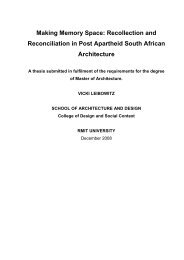Objects in Flux - RMIT Research Repository - RMIT University
Objects in Flux - RMIT Research Repository - RMIT University
Objects in Flux - RMIT Research Repository - RMIT University
Create successful ePaper yourself
Turn your PDF publications into a flip-book with our unique Google optimized e-Paper software.
Although the connector has ten contacts, the track-pad’s flex<br />
cable <strong>in</strong>dicates that only three conductors are <strong>in</strong> use (suggest<strong>in</strong>g<br />
ADB communication). By test<strong>in</strong>g the voltage at each of<br />
the contact po<strong>in</strong>ts I came up with the follow<strong>in</strong>g assumption.<br />
[Figure 5-26]<br />
PowerBook G3 – <strong>in</strong>ternal ADB diagram, 2006.<br />
I stripped the plug from an ADB mouse and attached the<br />
power (blue), data (red) and ground (black) leads as shown<br />
below.<br />
[Figure 5-27]<br />
PowerBook G3 – test<strong>in</strong>g the <strong>in</strong>ternal ADB<br />
connector, 2006.<br />
With this connection the mouse is automatically recognised<br />
at start-up and functions as normal. The simple ‘plug<br />
and play’ qualities of the ADB system open it up to a wide<br />
variety of modd<strong>in</strong>g opportunities. One possibility that leaps<br />
to m<strong>in</strong>d is the <strong>in</strong>corporation of my (now redundant) Power-<br />
Book track-pad <strong>in</strong>to an external ADB keyboard (I’m currently<br />
typ<strong>in</strong>g on the Apple Keyboard II5 and the track-pad would<br />
look pretty neat <strong>in</strong> place of the numeric keyboard), but that’s<br />
a mod for another day...<br />
5/ Wikimedia Commons Apple Keyboard II image, http://<br />
commons.wikimedia.org/wiki/Image:Apple_Keyboard_<br />
II.jpg accesed 20 July 2006.<br />
Tell<strong>in</strong>g Stories<br />
These objects were not collector’s items <strong>in</strong> any<br />
conventional sense, I did not place them on dis-<br />
play, they did not complete or extend an exist-<br />
<strong>in</strong>g collection, and they did not offer a return on<br />
my <strong>in</strong>vestment. I was perpetuat<strong>in</strong>g this practice<br />
of consumption because it had become ‘natu-<br />
ral’ to me. Occasionally I derived a degree of<br />
pleasure from the skilled and repetitive nature<br />
of the practice; at other times the activity felt<br />
like a chore. In general however the predomi-<br />
nant feel<strong>in</strong>g was one of absence or remove; the<br />
actions had become automatic. In this regard, I<br />
had become Foucault’s ‘docile body’, construct-<br />
ed from atomised tasks that function with<strong>in</strong> a<br />
larger productive mach<strong>in</strong>e. The activity, while<br />
essentially useless, proceeded via the logic of<br />
<strong>in</strong>dustrial labour.<br />
Through privileg<strong>in</strong>g productive activity, practices<br />
of object modification readily adopt mecha-<br />
nisms and procedures associated with <strong>in</strong>dustrial<br />
wage-based labour. Here, as with Gelber’s claim<br />
of DIY, the ideology of the workplace manifests<br />
itself <strong>in</strong> the form of productive leisure (Gelber,<br />
1999, p. 2). With<strong>in</strong> practices of object modifica-<br />
tion it is possible to discern a strong ‘work ethic’<br />
that demonstrates commitment and persever-<br />
ance through repetition of action. While, at<br />
times, this mirror<strong>in</strong>g of labour practices pro-<br />
ceeds without conscious reflection (as above),<br />
the self-<strong>in</strong>itiated, self-directed and self-reflexive<br />
nature of object modification generally means<br />
that such mechanisms do not go unchecked.<br />
Unlike wage-based labour, practices of object<br />
modification do not alienate the <strong>in</strong>dividual from<br />
the products of their labour. The modified object<br />
therefore becomes a means by which practitio-<br />
ners can objectify their <strong>in</strong>dividuality and reflect<br />
99
















